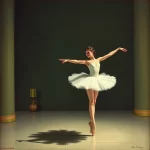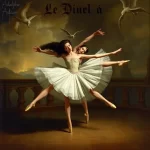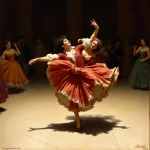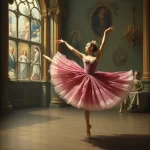Ballet: La Péri (Paul Dukas, 1912)

Introduction
Ballet, an art form that combines music, dance, and storytelling, has produced numerous masterpieces over the centuries. One such gem is “La Péri,” a ballet composed by Paul Dukas in 1912. This ballet, choreographed by Ivan Clustine, premiered on April 22, 1912, at the Théâtre du Châtelet in Paris. “La Péri” is a one-act ballet that delves into themes of love, desire, and the quest for immortality, set against the backdrop of Persian mythology.
Historical Background
Creation and Development
“La Péri” was created during a period of significant artistic innovation in the early 20th century. The ballet emerged in a time when composers and choreographers were exploring new forms and expressions in their work. Paul Dukas, a French composer known for his meticulous craftsmanship, drew inspiration from Persian folklore and literature, particularly the story of a Péri, a mythical fairy-like creature.
The collaboration between Dukas and Clustine was pivotal in bringing “La Péri” to life. Clustine, a Russian choreographer, was known for his ability to blend classical ballet techniques with innovative movements, which complemented Dukas’ rich and evocative score. Together, they created a ballet that was both visually and musically captivating.
Premiere and Reception
“La Péri” premiered on April 22, 1912, at the Théâtre du Châtelet in Paris. The initial reception was mixed; while some critics praised the ballet’s innovative choreography and lush musical score, others found it less accessible compared to more traditional ballets of the time. Despite the mixed reviews, “La Péri” gained a following and was performed by various ballet companies, leading to several notable revivals in the years that followed.
Synopsis of the Ballet
“La Péri” is a one-act ballet that tells the story of Iskender, a young prince who embarks on a quest to find the Flower of Immortality. His journey leads him to the realm of the Péris, where he encounters a beautiful Péri who guards the coveted flower.
Key Moments
- Iskender’s Quest: The ballet opens with Iskender’s determination to find the Flower of Immortality, driven by his desire for eternal life.
- Encounter with the Péri: Iskender reaches the realm of the Péris and meets the enchanting Péri, who is both alluring and mysterious.
- The Dance of the Péri: The Péri performs a mesmerizing dance, symbolizing the ethereal beauty and unattainable nature of immortality.
- The Flower of Immortality: Iskender attempts to seize the flower, but the Péri’s dance and presence make him question his quest.
- Resolution: In the end, Iskender realizes that true immortality lies not in a flower but in the beauty and experiences of life itself.
Musical Composition
Composer’s Role
Paul Dukas, a prominent French composer, played a crucial role in the creation of “La Péri.” Known for his orchestral work “The Sorcerer’s Apprentice,” Dukas brought his expertise in orchestration and thematic development to the ballet. His score for “La Péri” is characterized by its lush harmonies, intricate melodies, and evocative use of orchestral colors.
Musical Themes and Motifs
The music of “La Péri” is rich with recurring themes and motifs that enhance the narrative and emotional depth of the ballet. One of the most notable motifs is the “Péri’s Theme,” a delicate and ethereal melody that captures the otherworldly nature of the Péri. The score also features dynamic contrasts, from the powerful and dramatic passages representing Iskender’s quest to the serene and lyrical sections that accompany the Péri’s dance.
Famous Recordings and Performances
Several recordings of “La Péri” have been made over the years, showcasing the beauty and complexity of Dukas’ score. Notable recordings include those conducted by Charles Dutoit with the Montreal Symphony Orchestra and by Jean Martinon with the Orchestre National de l’ORTF. These recordings have helped to preserve and popularize the ballet’s music, allowing it to reach a wider audience.
Choreography and Dance
Choreographer’s Vision
Ivan Clustine’s choreography for “La Péri” was innovative for its time, blending classical ballet techniques with expressive movements that conveyed the mystical and emotional aspects of the story. Clustine’s vision was to create a ballet that was not only visually stunning but also deeply moving, capturing the essence of the characters and their journey.
Signature Dance Numbers
- The Dance of the Péri: This solo performance by the Péri is one of the highlights of the ballet, showcasing her ethereal beauty and grace.
- Iskender’s Quest: A powerful and dynamic dance that represents Iskender’s determination and struggle to find the Flower of Immortality.
- The Final Pas de Deux: A poignant and emotional duet between Iskender and the Péri, symbolizing the resolution of his quest and the realization of true immortality.
Notable Interpretations
Over the years, “La Péri” has been interpreted and adapted by various choreographers and ballet companies. Each production brings its own unique perspective to the ballet, highlighting different aspects of the story and characters. Notable interpretations include those by Rudolf Nureyev, who brought a dramatic intensity to the role of Iskender, and by Natalia Makarova, whose portrayal of the Péri was both captivating and deeply moving.
Characters and Roles
Main Characters
- Iskender: The young prince who embarks on a quest to find the Flower of Immortality. Driven by his desire for eternal life, Iskender’s journey leads him to a deeper understanding of true immortality.
- The Péri: A mythical fairy-like creature who guards the Flower of Immortality. The Péri’s ethereal beauty and enchanting dance captivate Iskender and ultimately lead him to a profound realization.
Supporting Characters
While “La Péri” primarily focuses on the interactions between Iskender and the Péri, there are other minor characters and mythical beings that add depth to the story. These supporting characters often appear in the background, enhancing the mystical and otherworldly atmosphere of the ballet.
Famous Dancers
Several renowned dancers have portrayed the roles of Iskender and the Péri over the years. Notable performers include Rudolf Nureyev, who brought a powerful presence to the role of Iskender, and Natalia Makarova, whose portrayal of the Péri was both graceful and emotionally resonant. These dancers have left a lasting impact on the ballet, contributing to its enduring legacy.
Cultural and Artistic Impact
Influence on Ballet and Dance
“La Péri” has had a significant influence on the world of ballet and dance. Its innovative choreography and rich musical score have inspired other choreographers and composers to explore new forms of expression. The ballet’s themes of love, desire, and the quest for immortality continue to resonate with audiences and artists alike, making it a timeless work in the ballet repertoire.
Cultural Significance
The cultural significance of “La Péri” extends beyond the world of ballet. The ballet’s exploration of Persian mythology and folklore has contributed to a greater appreciation of these cultural narratives in Western art. Additionally, “La Péri” has been referenced in literature, film, and other media, highlighting its enduring impact on popular culture.
Legacy and Revivals
“La Péri” has seen numerous revivals and reinterpretations over the years, each bringing new life to the ballet. Major revivals have been staged by prominent ballet companies such as the Paris Opera Ballet and the Royal Ballet, ensuring that the ballet continues to be performed and celebrated today. These revivals have helped to preserve the ballet’s legacy and introduce it to new generations of audiences.
Iconic Productions
Historic Productions
One of the most famous historical productions of “La Péri” was staged by the Paris Opera Ballet in the 1920s. This production featured renowned dancers such as Serge Lifar and Yvette Chauviré, who brought their own unique interpretations to the roles of Iskender and the Péri. The production was praised for its innovative choreography and stunning visual design, setting a high standard for future performances.
Contemporary Productions
Recent productions of “La Péri” have continued to explore new interpretations of the ballet. Contemporary choreographers have experimented with different styles and techniques, bringing fresh perspectives to the story and characters. These modern adaptations often incorporate innovative set and costume designs, enhancing the visual and emotional impact of the ballet.
Production Design
The production design of “La Péri” plays a crucial role in creating the mystical and enchanting atmosphere of the ballet. Set designs often feature elaborate and fantastical elements, such as lush gardens and ethereal landscapes, that transport audiences to the realm of the Péris. Costume designs are equally important, with intricate and flowing garments that reflect the otherworldly beauty of the characters.
Critical Reception and Reviews
Initial Critical Response
At the time of its premiere, “La Péri” received mixed reviews from critics. While some praised the ballet’s innovative choreography and lush musical score, others found it less accessible compared to more traditional ballets. Despite these initial mixed reactions, “La Péri” gained a following and was performed by various ballet companies, leading to several notable revivals in the years that followed.
Modern Reviews
Contemporary critics and audiences have come to appreciate “La Péri” for its artistic innovation and emotional depth. Modern reviews often highlight the ballet’s rich musical score and captivating choreography, as well as its timeless themes of love and desire. The ballet’s enduring popularity is a testament to its significance in the world of dance and its ability to resonate with audiences across generations.
Fun Facts and Trivia
Behind-the-Scenes Stories
One interesting behind-the-scenes story from the production of “La Péri” involves the creation of the Péri’s costume. The original costume design featured intricate and delicate fabrics that were meant to capture the ethereal beauty of the character. However, during rehearsals, it was discovered that the costume was too fragile for the demanding choreography, leading to a last-minute redesign that balanced both beauty and practicality.
Notable Performers
Several famous dancers have been associated with “La Péri” over the years. Rudolf Nureyev, one of the most celebrated dancers of the 20th century, brought a powerful presence to the role of Iskender. Natalia Makarova, known for her grace and emotional depth, delivered a captivating performance as the Péri. These dancers have left a lasting impact on the ballet, contributing to its enduring legacy.
Trivia
- “La Péri” is one of the few ballets composed by Paul Dukas, who is more widely known for his orchestral work “The Sorcerer’s Apprentice.”
- The ballet’s premiere at the Théâtre du Châtelet in Paris was part of a double bill, paired with another ballet to attract a wider audience.
- The Flower of Immortality, central to the ballet’s plot, is a symbol often found in Persian mythology and literature, representing eternal life and divine beauty.
Conclusion
Summary of the Ballet’s Importance
“La Péri” holds a significant place in the world of ballet for its innovative choreography, rich musical score, and timeless themes. The collaboration between Paul Dukas and Ivan Clustine resulted in a ballet that continues to captivate audiences with its beauty and emotional depth. Its exploration of Persian mythology adds a unique cultural dimension, making it a standout work in the ballet repertoire.
Final Thoughts
“La Péri” is a testament to the power of collaboration and artistic innovation. Its enduring popularity and continued performances highlight its relevance and impact on the world of dance. For those who have not yet experienced this enchanting ballet, it is highly recommended to watch a performance or listen to the score to fully appreciate its beauty and significance.
FAQ
What is the central theme of this ballet?
The central theme of “La Péri” is the quest for immortality and the realization that true immortality lies in the beauty and experiences of life itself.
Who are the main characters in this ballet?
The main characters in “La Péri” are Iskender, a young prince on a quest for the Flower of Immortality, and the Péri, a mythical fairy-like creature who guards the flower.
What is the most famous dance number in this ballet?
The most famous dance number in “La Péri” is the Dance of the Péri, a solo performance that showcases the ethereal beauty and grace of the Péri.
How long does a typical performance of this ballet last?
A typical performance of “La Péri” lasts approximately 30 to 40 minutes, as it is a one-act ballet.
Are there any modern adaptations of this ballet?
Yes, there have been several modern adaptations of “La Péri,” with contemporary choreographers bringing new interpretations and styles to the ballet.
Why is this ballet considered important in the history of dance?
“La Péri” is considered important in the history of dance for its innovative choreography, rich musical score, and exploration of timeless themes. Its influence on other works and its continued popularity highlight its significance in the ballet repertoire.





